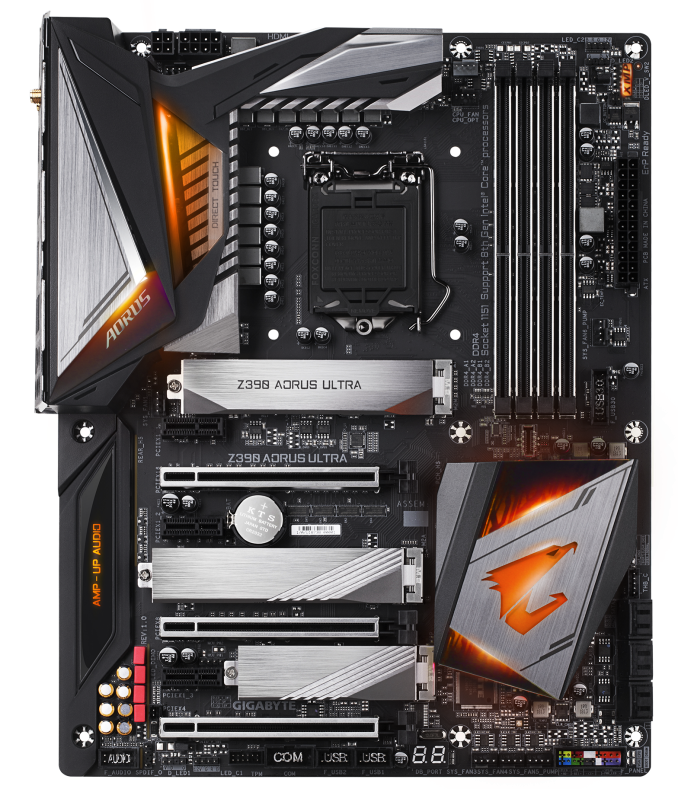Intel Z390 Motherboard Overview: 50+ Motherboards Analyzed
by Ian Cutress & Gavin Bonshor on October 8, 2018 10:53 AM EST- Posted in
- Motherboards
- Intel
- MSI
- Gigabyte
- ASRock
- EVGA
- Asus
- NZXT
- Supermicro
- Z390
GIGABYTE Z390 Aorus Ultra
As GIGABYTE has moved away from their numbering scheme and elected to use a more prominent gaming scheme, the previous Z370 Aorus Gaming 5 which sat in the mid-range of GIGABYTEs Intel range has been replaced by the Z390 Aorus Ultra. Aesthetically not much has changed as both models have integrated RGB LED lighting at various points across the board including the power delivery and chipset heatsinks and the Z390 does include a total of (insert) RGB headers to further expand the RGB capabilities of the board. Just like the Gaming 5, the Z390 Aorus Ultra has integrated 802.11ac Wi-Fi on top of a single LAN port so users can get the best of both worlds when connecting to a network. GIGABYTE also advertises a 13-phase VRM (12+1) so there should be plenty of headroom available for users looking to overclock the new 9th generation Intel processors.
The Z390 Aorus Ultra shares similar characteristics as the Z370 Gaming 5 such as three full-length PCIe 3.0 slots which operate at x16, x8 and x4 from top to bottom respectively. GIGABYTE has upgraded the previous board as the Z390 Aorus Ultra now has metal slot protection on all of the full-length PCIe 3.0 slots. Also included on the board is three PCIe 3.0 x1 slots.
While both the Z370 Aorus Gaming 5 and the new Z390 Aorus Ultra has three PCIe 3.0 x4/2 M.2 slots, all three slots now include a dedicated M.2 heatsink to aid in heat dissipation on the newer Z390 option. The board also makes use of six SATA slots with support for RAID 0, 1, 5 and 10 arrays. Focusing on memory, the Z390 Aorus Ultra has compatibility with DDR4-4133 RAM and up to a maximum supported capacity of 64 GB across four RAM slots.
On the rear panel, there are three USB 3.1 Gen2 Type-A, one USB 3.1 Gen2 Type-C and four USB 2.0 ports. Like the Z390 Aorus Master, there are also two USB 3.0 Type-A ports marked with GIGABYTE's DAC-UP audio boost technology. The Z390 Aorus Ultra has support for 2T2R Wave 2 802.11ac wireless networking and the single LAN port is controlled by an Intel I219V Gigabit networking controller. A single HDMI video output is featured for users looking to utilize the integrated graphics on supported 8th and 9th generation Intel processors and the onboard audio which consists of five 3.5 mm audio jacks and an S/PDIF optical output are controlled by a Realtek ALC1220-VB HD audio codec.
The GIGABYTE Z390 Aorus Ultra is a mid-high end Z390 option which costs $250 aimed towards gamers and enthusiasts looking to make use of multi-graphics card configurations and multiple M.2 storage devices with each slot garnering support for NVMe based drives. A handy LED debugger is also featured meaning users looking to overclock their processors have a handy method of diagnosing failed overclocks as well as POST related issues.












79 Comments
View All Comments
Smell This - Tuesday, October 9, 2018 - link
Much.Of.
The.
Same.
2 HSIO lanes per Gen 2 port and WiFi. Wow (rolling I-eyeballs) ...
MadAd - Tuesday, October 9, 2018 - link
58 motherboards, only 13 of which are smaller than ATX. When on earth are we going to move off this outdated oversized format? Its just more of the same every time, so depressing.gavbon - Wednesday, October 10, 2018 - link
13 is better than 0, or 12 :DMadAd - Wednesday, October 10, 2018 - link
Considering very small form formats (ITX) are harder to build for and only 7 are uATX, a size which is the most useful to transition away from ATX then no, it feels like an afterthought from a lazy industry. I mean who uses more than 1 main video card and 2-4 sticks of ram in a gaming PC these days? Even water builds into uATX isnt that hard to accomplish.After literally decades ATX should be a choice for edge cases not a mainstream build.
shaolin95 - Monday, October 22, 2018 - link
who cares about midge boards!Edkiefer - Wednesday, October 10, 2018 - link
All these MB with 2x 8 pin power inputs, is both mandatory and if so I guess new PSU will need 2x 8pin now.entity279 - Wednesday, October 10, 2018 - link
so it's ok to just buy SM motherboards now with them being involved in a security scandal?gavbon - Thursday, October 11, 2018 - link
I currently have the Supermicro C9Z390-PGW awaiting to go on the test bench next week, so from a consumers standpoint, I could potentially shed light on that board. As far as the Chinese/Supermicro/Spy scandal goes, I don't want to speculate without the finer details.eastcoast_pete - Wednesday, October 10, 2018 - link
Ian & Gavin, thanks for the overview.@ both - Question: I've read that Intel, to deal with its bad planning/capacity problems on 14 nm, has contracted the fabbing of some of its chipsets out to TSMC, specifically in TSMC's 22 nm tech. Is that correct, and did you have a chance to confirm that the new 390s used by these boards are indeed made by Intel on their 14 nm FinFET tech, or are they made by a contractor (TSMC)?
DanNeely - Wednesday, October 10, 2018 - link
AFAIK the chipsets being reverted to 22nm are using Intel's 22nm process in old unupgraded fabs. Doing so would be far less work than porting to a process from a different company; the latter would require massive rework to follow a completely different set of design rules.